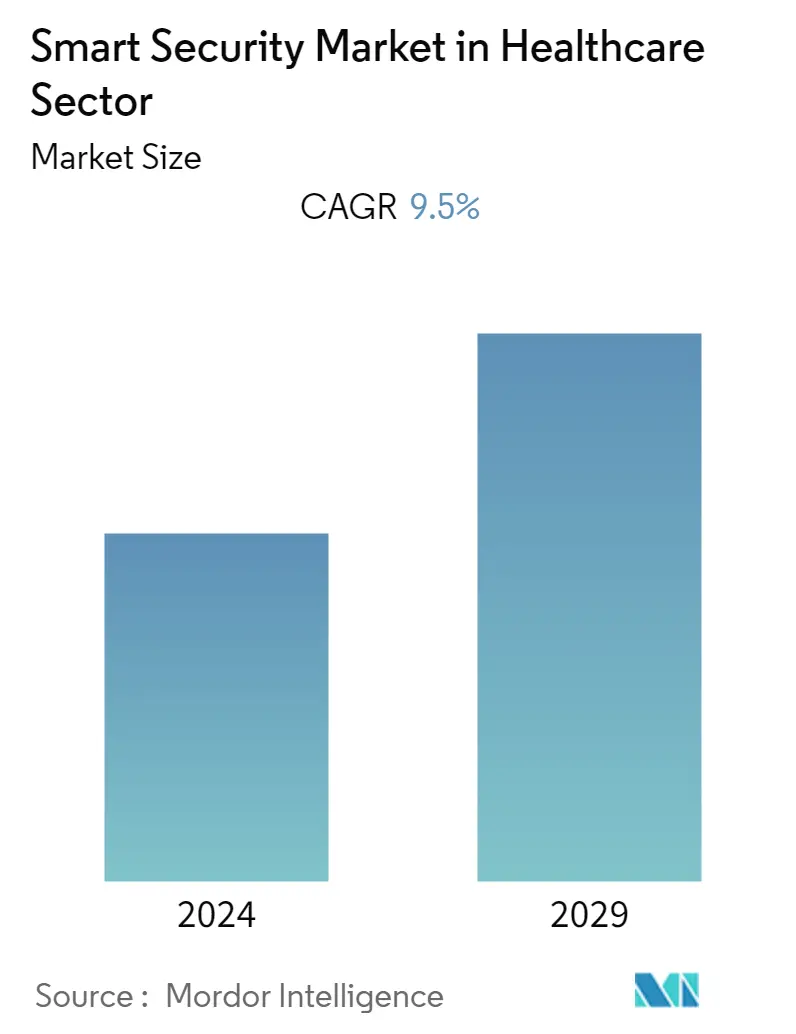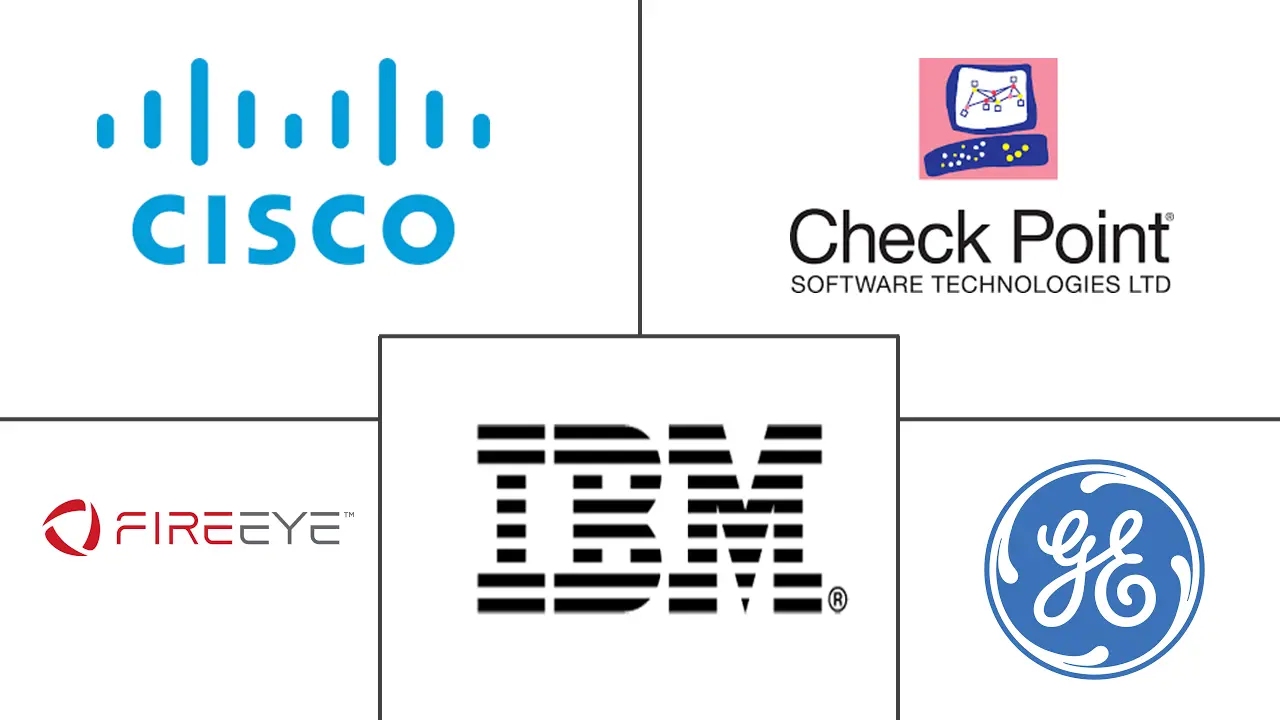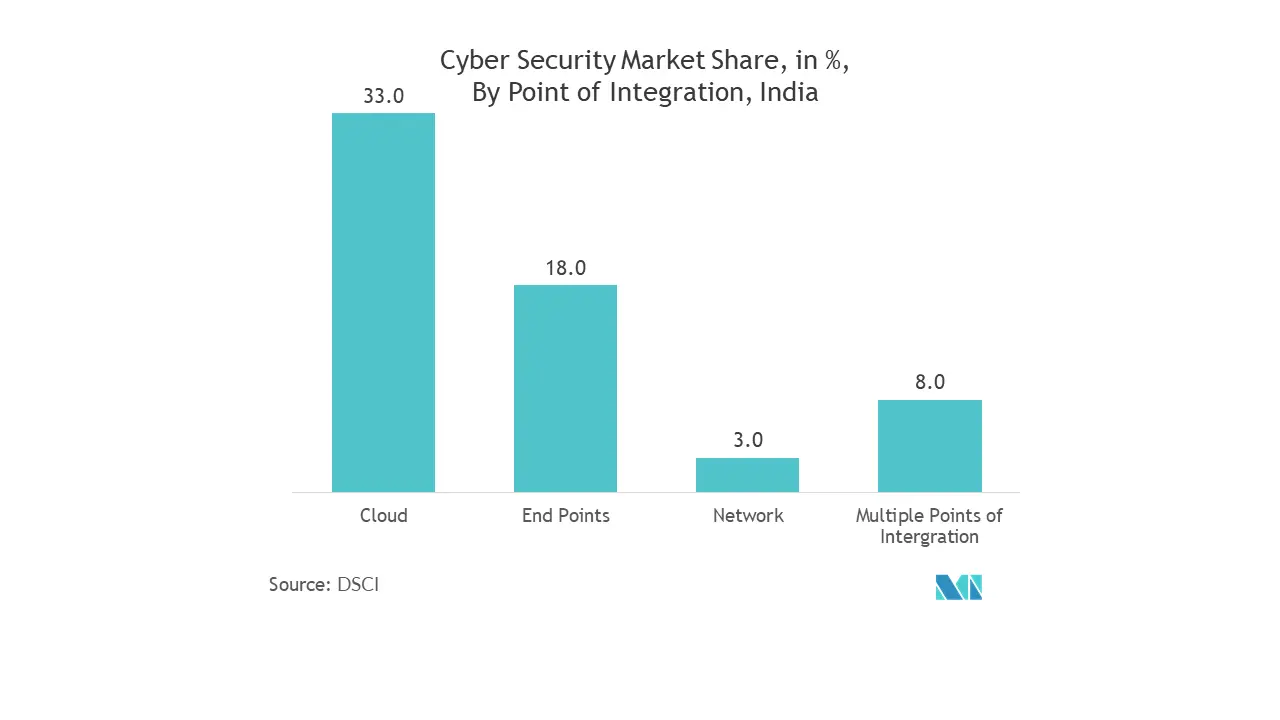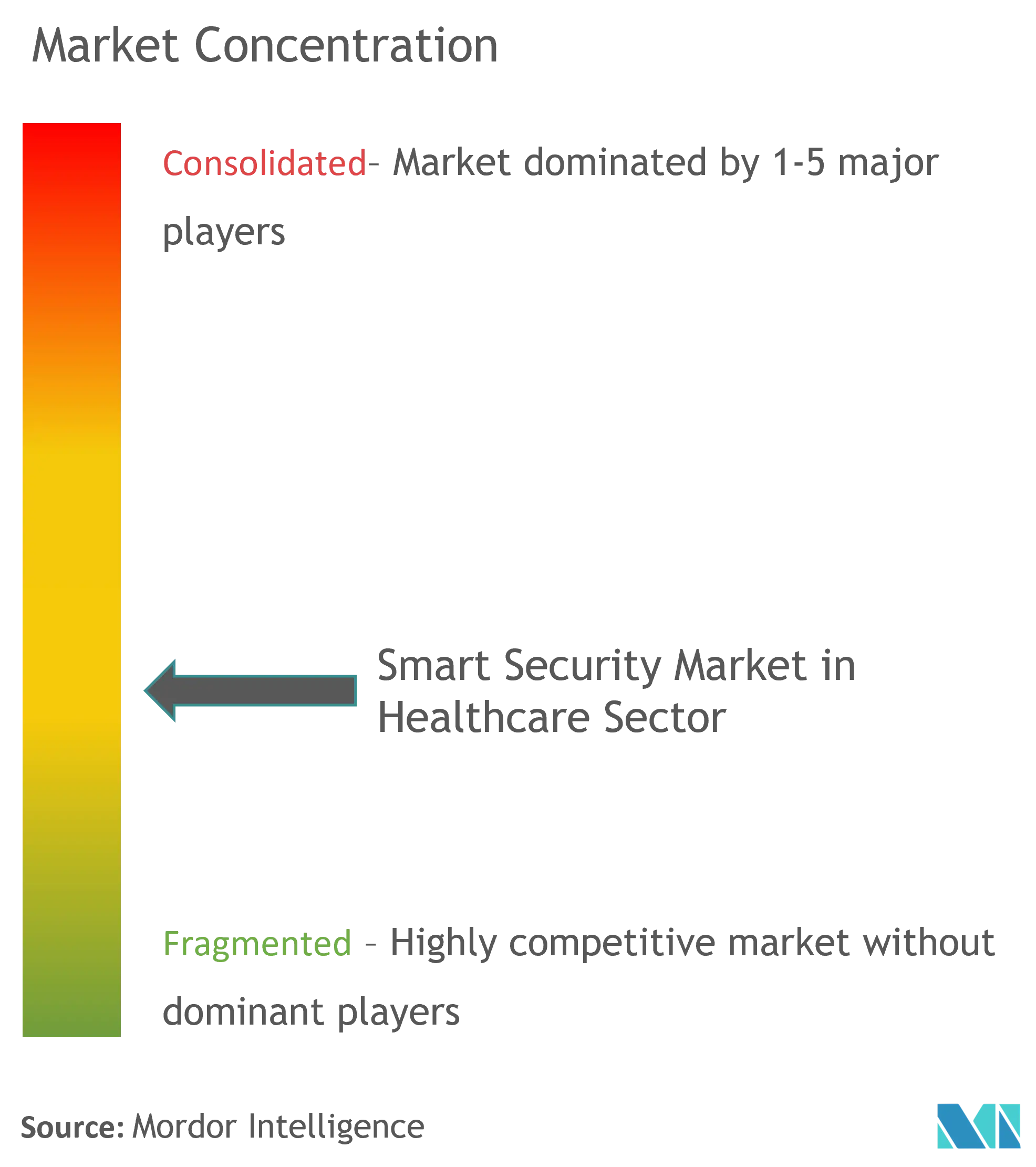Healthcare Smart Security Market Size

| Study Period | 2019 - 2029 |
| Base Year For Estimation | 2023 |
| CAGR | 9.50 % |
| Fastest Growing Market | North America |
| Largest Market | Asia-Pacific |
| Market Concentration | Medium |
Major Players
*Disclaimer: Major Players sorted in no particular order |
Healthcare Smart Security Market Analysis
The Smart Security Market in Healthcare Sector is expected to grow at a CAGR of 9.5% over 2021 - 2026. Healthcare delivery organizations quickly scaled the implementations of technologies designed to support the response to COVID-19, including telehealth platforms and other patient support technologies. This included temporary care sites and labs, along with troves of connected devices and telehealth platforms desperately needed to support patient care.
- The healthcare industry has been witnessing a significant transformation over the course of the past few years, aided by the transformative nature of IoT technologies and advancements in computing power, wireless technologies, and data analytics techniques, such as Big Data, which is currently being deployed in the medical facilities and in the medical research sector for the analysis of a large amount of complex heterogeneous medical data that involves proteomics, genomics, and pharmacogenomics, across the world.
- Owing to the digital transformation, the healthcare industry is witnessing a shift in its operational process of information security and several healthcare breaches in the healthcare sector. As per the 2021 Protenus Breach Barometer Report, 40.7 million healthcare records were compromised in 2020, whereas health data breaches were up by 30% in 2020 compared to 2021.
- The latest developments in the healthcare sector, such as the deployment of Internet of Medical Things (IoMT) devices, opened the door for improved patient care and increased potential threats. Embedded devices, such as pacemakers, also pose a threat to the patient's health, as they use radio or network technology.
- The healthcare industry is currently undergoing a transformation in cyber security strategy from a compliance and Health Insurance Portability and Accountability Act (HIPAA)-focused approach to a more comprehensive and security-centric approach. Going forward, the governments are expected to impose stricter regulations pertaining to the safety and security of IoMT devices. Moreover, healthcare providers will have to step up the game on cyber resilience.
Healthcare Smart Security Market Trends
This section covers the major market trends shaping the Healthcare Smart Security Market according to our research experts:
End Point Security Expected to Witness Significant Growth
- The Modern healthcare endpoint security and protection often feature patch management and other endpoint management capabilities that cater to the healthcare sector. Many healthcare industry players incorporate endpoint security, which alerts their IT security team when a device lacks a security patch or is using outdated information. It also allows them to schedule when the patch should be downloaded or updated to not interfere with business processes. This contributes to a consistent security layer.
- Healthcare employees' increasing number of connected devices leads to increased information sharing. Still, it places the endpoint at higher risk than ever before. For instance, according to an ETNO report, in the EU region alone, the number of IoT-connected healthcare devices for FY 2020 amounted to more than 3.10 million.
- COVID-19 forced many employees into remote working situations, which naturally increased the number and variety of endpoints. Endpoint security became a significant component of every healthcare organization's cybersecurity program. It only takes one susceptible endpoint for a threat actor to gain access and facilitate a healthcare cyberattack—and with an increase in remote work, bring-your-own-device (BYOD), and a growing number of connected devices across healthcare IT networks.
- The market is witnessing various partnerships, mergers, and acquisitions. For instance, in September 2021, Medigate, a prominent KLAS IoT Security Provider in healthcare, announced a partnership with CrowdStrike, a provider of cloud-delivered endpoint and workload protection, to offer healthcare delivery organizations (HDOs) with the company's first consolidated view of threat activity and incident response capability spanning all connected assets.

North America Expected to Witness Significant Growth
- The healthcare industry is one of the most regulated industries in North America due to privacy and security concerns associated with digital patient records. Companies are rolling out innovative products to safeguard patient data. For instance, Cisco released the latest version of the Cisco Umbrella and deployed it in the University of Kansas Hospital to protect medical devices and financial information from ransomware.
- To fight the continuous threats plaguing the healthcare industry, the Department of Homeland Security (DHS) and the American Hospital Association (AHA) conducted a webinar focusing on current cybersecurity threats to the healthcare sector. It encouraged healthcare professionals to gain knowledge about the best practices regarding medical security, thereby encouraging market growth.
- Apart from the United States, Canada actively focuses on enhancing medical device security. In July 2021, Relay Medical Corp announced an engagement to provide the Cybeats integrated cybersecurity platform to StarFish Product Engineering Inc., Canada's largest medical device design consultancy. Under the engagement, Relay will provide the Cybeats cybersecurity platform to StarFish Medical for high-valued connected medical devices.
- Owing to increasing security breaches, in September 2021, Ordr, an IT security firm for connected devices, launched a guide to help National Health Service (NHS) providers meet NHS Digital's new Data Security and Protection Toolkit (DSPT) criteria.
.webp)
Healthcare Smart Security Industry Overview
The Global Smart Security Market in Healthcare Sector is moderately competitive in nature. Product launches, high expense on research and development, partnerships, and acquisitions are the prime growth strategies adopted by the companies in the market to sustain the intense competition.
- November 2021 - IBM announced plans to acquire endpoint security firm ReaQta, expanding its presence in the extended detection and response (XDR) market. With expanded capabilities through QRadar XDR and the planned addition of ReaQta, IBM is assisting clients in staying ahead of attackers by providing the first XDR solution that reduces vendor lock-in through the use of open standards.
- March 2021 - Cisco announced the expansion of its Secure Access Service Edge (SASE) offering. This is a significant step forward in Cisco's journey to radically simplify security and networking by assisting network operations (NetOps) and security operations (SecOps) teams in securely connecting users to applications. In addition, Cisco announced enhancements to its cloud-native platform, SecureX, to help it manage new and emerging threats more quickly and effectively.
Healthcare Smart Security Market Leaders
-
Cisco Systems Inc.
-
Check Point Software Technologies
-
IBM Corporation
-
FireEye Inc.
-
General Electric Company
*Disclaimer: Major Players sorted in no particular order

Healthcare Smart Security Market News
- February 2020 - GE Healthcare introduced a new cybersecurity service offering that primarily brings together medical device expertise, artificial intelligence, and process management tools to help the hospital groups fight against cybersecurity threats. The new solution, called Skeye, will augment the hospitals' existing resources and capabilities by providing proactive monitoring through a remote security operations center (SOC), helping them detect, analyze, and respond to any cybersecurity threats events in real-time.
Healthcare Smart Security Market Report - Table of Contents
1. INTRODUCTION
- 1.1 Study Assumptions and Market Definition
- 1.2 Scope of the Study
2. RESEARCH METHODOLOGY
3. EXECUTIVE SUMMARY
4. MARKET INSIGHTS
- 4.1 Market Overview
-
4.2 Industry Attractiveness - Porter's Five Forces Analysis
- 4.2.1 Bargaining Power of Suppliers
- 4.2.2 Bargaining Power of Consumers
- 4.2.3 Threat of New Entrants
- 4.2.4 Threat of Substitutes
- 4.2.5 Intensity of Competitive Rivalry
- 4.3 Impact of COVID-19 on the Market
5. MARKET DYNAMICS
-
5.1 Market Drivers
- 5.1.1 Increasing Demand for Connected Medical Security
- 5.1.2 Government Regulations and Need for Compliance
-
5.2 Market Challenges
- 5.2.1 Limited Healthcare Security Budgets
6. MARKET SEGMENTATION
-
6.1 By Security
- 6.1.1 Network Security
- 6.1.2 Cloud Security
- 6.1.3 End Points Security
-
6.2 By Application
- 6.2.1 Life Sciences
- 6.2.2 Hospitals
- 6.2.3 Health Insurance Providers
-
6.3 By Geography
- 6.3.1 North America
- 6.3.2 Europe
- 6.3.3 Asia Pacific
- 6.3.4 Latin America
- 6.3.5 Middle East and Africa
7. COMPETITIVE LANDSCAPE
-
7.1 Company Profiles
- 7.1.1 Check Point Software Technologies
- 7.1.2 Cisco Systems Inc.
- 7.1.3 FireEye Inc.
- 7.1.4 McAfee LLC
- 7.1.5 Palo Alto Networks Inc.
- 7.1.6 IBM Corporation
- 7.1.7 Imperva Inc.
- 7.1.8 Fortinet Inc.
- 7.1.9 General Electric Company
- 7.1.10 ClearDATA
- *List Not Exhaustive
8. INVESTMENT ANALYSIS
9. FUTURE OF THE MARKET
** Subject To AvailablityHealthcare Smart Security Industry Segmentation
The study estimates cover both the spending and trend analysis of different types of security used such as Network Security, Cloud Security, End Point Security used in various applications such as Life Sciences, Hospitals, Health Insurance Providers.
The report also covers the analysis of the impact of COVID-19 on the market and the stakeholders, and the same has been considered for the current market estimation and future projections.
| By Security | Network Security |
| Cloud Security | |
| End Points Security | |
| By Application | Life Sciences |
| Hospitals | |
| Health Insurance Providers | |
| By Geography | North America |
| Europe | |
| Asia Pacific | |
| Latin America | |
| Middle East and Africa |
Healthcare Smart Security Market Research FAQs
What is the current Smart Security Market in Healthcare Industry size?
The Smart Security Market in Healthcare Industry is projected to register a CAGR of 9.5% during the forecast period (2024-2029)
Who are the key players in Smart Security Market in Healthcare Industry?
Cisco Systems Inc., Check Point Software Technologies, IBM Corporation, FireEye Inc. and General Electric Company are the major companies operating in the Smart Security Market in Healthcare Industry.
Which is the fastest growing region in Smart Security Market in Healthcare Industry?
North America is estimated to grow at the highest CAGR over the forecast period (2024-2029).
Which region has the biggest share in Smart Security Market in Healthcare Industry?
In 2024, the Asia-Pacific accounts for the largest market share in Smart Security Market in Healthcare Industry.
What years does this Smart Security Market in Healthcare Industry cover?
The report covers the Smart Security Market in Healthcare Industry historical market size for years: 2019, 2020, 2021, 2022 and 2023. The report also forecasts the Smart Security Market in Healthcare Industry size for years: 2024, 2025, 2026, 2027, 2028 and 2029.
Smart Security in Healthcare Sector Industry Report
Statistics for the 2024 Smart Security in Healthcare Sector market share, size and revenue growth rate, created by Mordor Intelligence™ Industry Reports. Smart Security in Healthcare Sector analysis includes a market forecast outlook to 2029 and historical overview. Get a sample of this industry analysis as a free report PDF download.



